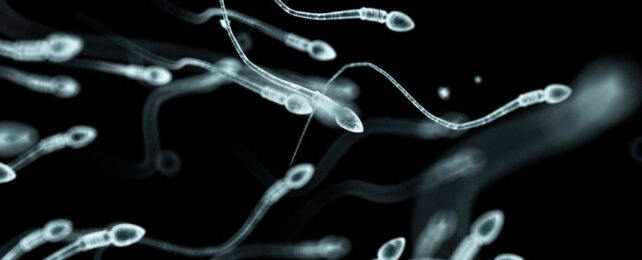A new type of male contraceptive that doesn't rely on hormones has shown preliminary success in mice. The novel medicine is not only reversible; it comes with very few side effects.
Clinical trials for humans are still years away, but in initial experiments on rodents, the right dose of medicine at the right time can enter the bloodstream, cross into the testes, and curtail the hyperactivity of sperm.
The compound is called CDD-2807, and US researchers led by Baylor College of Medicine are keen to keep studying it.
When the team injected roughly a dozen mice with CDD-2807 daily for 21 days, the male mice given one of the dosages sired no litters. This was despite the fact that males and females were still living together and mating. Once the drugs were stopped for about 53 days, the males started siring offspring once again.
When examining the testes of the male mice, researchers found that those dosed with CDD-2907 had a lower sperm count, lower sperm motility, and fewer hyperactivated sperm compared to controls.
"We were pleased to see that the mice did not show signs of toxicity from CDD-2807 treatment, that the compound did not accumulate in the brain, and that the treatment did not alter testis size," says pathologist Courtney Sutton.
"Importantly, the contraceptive effect was reversible. After a period without compound CDD-2807, the mice recovered sperm motility and numbers and were fertile again."
Researchers discovered the sperm-slowing activity of CDD-2807 in a bank of possible drugs. It stood out because of its ability to inhibit a protein called serine/threonine kinase 33 (STK33), which is enriched in the testes of mammals.
In both mice and humans without the STK33 gene, which codes for the STK33 protein, studies have shown sperm defects occur that lead to infertility, although there don't seem to be other health concerns associated with the variant.
"STK33 is therefore considered a viable target with minimal safety concerns for contraception in men," explains reproductive biologist Martin Matzuk, who runs the lab at Baylor.
The first female birth control pill was introduced nearly 60 years ago, and today there are numerous new forms available to female-bodied individuals, from oral pills to implanted devices.
By contrast, the last new male contraceptive to hit the market was in the 1980s when scientists figured out how to do a minimally invasive vasectomy.
For decades now, the public and scientists alike have discussed the possibility of a male form of birth control. Ideas have ranged from heating up the testicles with nanoparticles, to 'switching off' sperm with a pill, to an injectable hormonal 'plug' for the testes.
But while some of these methods show success in mice, designing a human medicine that is long-acting, reversible, and without side effects has proven tricky.
In 2016, a clinical trial for a male contraceptive was halted for negative side effects. Yet many were quick to point out the double standard: those very same side effects, such as loss of libido, mood changes, and depression, are considered acceptable when the contraception is destined for women.
When the female birth control pill was first introduced in the 1960s, the high doses of hormones caused severe and risky side effects, some of which increased heart attacks or strokes among patients.
Still, it took scientists more than a decade to figure that out, even though unpleasant and sometimes fatal side effects were apparent in the very first clinical trials in the 1950s.
Today, the process behind human drug research is much more stringent, which is obviously a great improvement, but it also means that it's taking longer for scientists to 'level the playing field' when it comes to the burden of contraception.
Scientists at Baylor College of Medicine are trying to close that gap, and their contraceptive candidate seems to be very effective at disrupting sperm function in mice. The team now wants to test their "excellent chemical probe" in non-human primates.
The study was published in Science.
